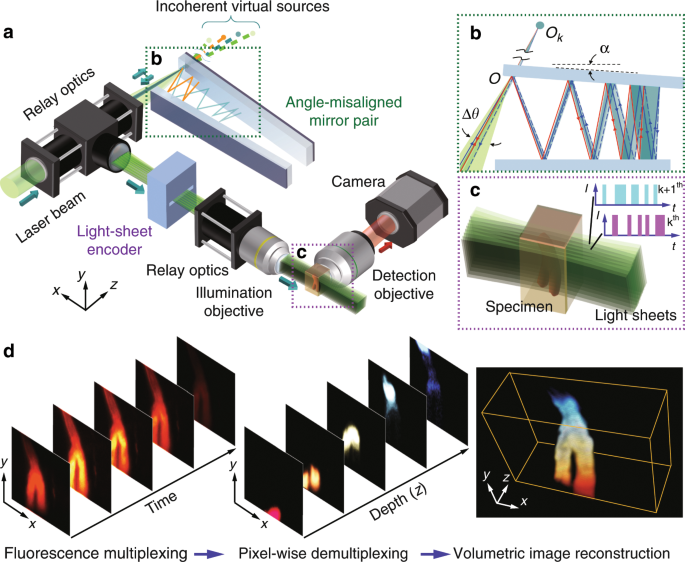(Eindhoven researchers present revolutionary light-emitting silicon)
2020/4/8 アイントホーフェン工科大学(TU/e)
_no%20white%20border_30f0231a84.jpg)
・ TU/e、ドイツ・フリードリヒ・シラー大学イェーナ、オーストリア・ヨハネスケプラー大学リンツおよびドイツ・ミュンヘン工科大学が、シリコンとゲルマニウムの六方晶合金による発光を実証。フォトニックチップ実現の可能性が期待できる。
・ 現在の電子チップベースの技術では、年毎に増加するデータ量の処理能力が限界に近づいているが、これはチップ上で無数のトランジスタを接続する銅ワイヤ中を電子が移動する際に受ける抵抗で発生する熱の問題によるもの。
・ この問題の解決には、電子に代わりフォトン(光子)を利用するフォトニクス技術が有効。フォトンは質量や電荷を持たず、材料中の移動において散乱が少ないため熱を出さない。
・ これによりエネルギー消費量が低減し、さらにチップでの電気通信が光通信となることでチップ上とチップ間の通信速度が 1000 桁向上する。データ通信をより高速化し、冷却システムの消費電力を削減するため、データセンターでの導入が最も効果的となる。
・ チップで光を利用するには、光源となる集積レーザーが必要となる。コンピューターチップに使用されるシリコンは、バルクでの発光効率が極めて非効率でフォトニクスには適さず、発光能力に優れるガリウムヒ素やインジウムリン等の材料が注目されている。しかし、これらの材料は高価な上、従来のシリコン製マクロチップへの統合が困難。
・ 50年来の理論では、シリコンとゲルマニウムの合金の六方晶構造で電子の直接遷移で発光が起こるとされるが、六方晶シリコンの作製は容易ではない。同大学は 2015 年に六方晶シリコンの作製に成功したが、発光できなかった。
・ 今回、不純物や結晶欠陥を低減することで六方晶シリコン-ゲルマニウムシェルの品質を改善し、効率的な発光を実証。ヒ化ガリウムやリン化インジウムにほぼ匹敵する光学特性と材料品質の向上を確認しているため、順調に進めば 2020 年内にのシリコンベースのレーザーが作製できると考える。
・ 当面は、本研究の必要条件であるシリコンマイクロエレクトロニクスへの六方晶シリコンの統合について研究を進める。
・ 本研究は、TU/e の Jos Haverkort が取り纏める EU プロジェクトの SiLAS により資金を得た。
URL: https://www.tue.nl/en/news/news-overview/08-04-2020-eindhoven-researchers-presentrevolutionary-light-emitting-silicon/
<NEDO海外技術情報より>
(関連情報)
Nature 掲載論文(アブストラクトのみ:全文は有料)
Direct-bandgap emission from hexagonal Ge and SiGe alloys
URL: https://www.nature.com/articles/s41586-020-2150-y
Abstract
Silicon crystallized in the usual cubic (diamond) lattice structure has dominated the electronics industry for more than half a century. However, cubic silicon (Si), germanium (Ge) and SiGe alloys are all indirect-bandgap semiconductors that cannot emit light efficiently. The goal1 of achieving efficient light emission from group-IV materials in silicon technology has been elusive for decades2,3,4,5,6. Here we demonstrate efficient light emission from direct-bandgap hexagonal Ge and SiGe alloys. We measure a sub-nanosecond, temperature-insensitive radiative recombination lifetime and observe an emission yield similar to that of direct-bandgap group-III–V semiconductors. Moreover, we demonstrate that, by controlling the composition of the hexagonal SiGe alloy, the emission wavelength can be continuously tuned over a broad range, while preserving the direct bandgap. Our experimental findings are in excellent quantitative agreement with ab initio theory. Hexagonal SiGe embodies an ideal material system in which to combine electronic and optoelectronic functionalities on a single chip, opening the way towards integrated device concepts and information-processing technologies.



